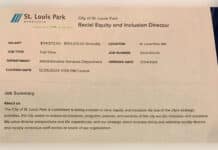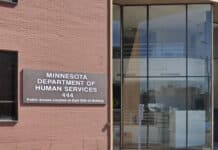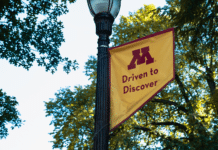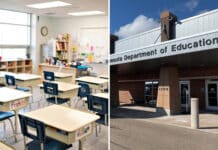(Opportunity for All Kids) — The much-discussed school choice boom happening in the United States since COVID has largely been contained in Southern and Central states, as seen in the chart below from EdChoice Kentucky.
The dark blue states indicate which areas have both private and public school choice, and for many of these states, that also means they have Education Savings Accounts (ESAs), allowing families to receive a portion of state education funding and use it toward tuition, books, and other educational expenses of their choice.

The South appears to be rising again, for the school choice surge that it began is starting to infiltrate more and more Northern, Central, and Western states. And that infiltration will directly affect Minnesota … for better or for worse.
Let’s take another look at that chart to see how this trend will change things for our state.
Currently, Minnesota is a light blue state, meaning it has a public charter school law, but no options for private school options such as ESAs.
To the east we find Wisconsin, a dark blue state. Although Wisconsin does not yet have one of the increasingly popular ESA programs, it does have the famous Milwaukee voucher program.
Under Milwaukee’s program, students hailing from families who make less than $90,000 per year are eligible for a scholarship of around $10,000 per year to use at the school of their choice. Currently this only applies to about 5% of children in the state of Wisconsin, although the state does have other school choice programs.
To the south of Minnesota we find Iowa, which does have an ESA program. Enacted in 2023, this program will extend to all students in the state in the 2025-2026 school year, providing each child with around $7,500 to use toward private school tuition, tutoring, and many other education services.
The states to Minnesota’s west now appear to be following Iowa’s lead. In the last few days, both governors unveiled plans to bring ESAs to their respective states.
“[P]arents should have the tools to choose what educational path is best for their kids,” South Dakota Gov. Kristi Noem said. “I am proposing that we establish education savings accounts for South Dakota students in this upcoming legislative session.”
North Dakota Gov. Doug Burgum followed her lead the next day, also calling for ESAs. This move in support of one of the strongest forms of school choice says a lot about Burgum’s commitment to such legislation, particularly as he vetoed a school choice bill last year because it “did not go far enough” in his eyes.
Both legislative bodies in North and South Dakota are Republican—a party which is often very pro-school-choice—so the likelihood of these states having ESAs before long looks quite positive.
That means that Minnesota will be the lone state standing in a sea of private school choice options.
How will that affect our state?
For one thing, it may cause us to lose more of our population.
Population decline is already a thing in Minnesota. The state “has seen a rate of outflow to other parts of the United States since 2019 which is worse than in 35 out of 50 states,” economist John Phelan noted in an article for the Center of the American Experiment earlier this year, a fact shown in the chart below:

Add school choice opportunities into the equation, and the decline will likely only accelerate.
After all, a cross-country move to a Southern state that has school choice is a major decision. But moving next door to a neighboring state? That’s not so hard.
Families can still enjoy the Midwest culture they’re used to, as well as being relatively near to family and friends they may have in Minnesota.
If a family can find a job that pays equally well as the one they had in Minnesota, moving to a state that offers ESAs is like getting a pay raise—particularly if a family has several children—for it offers thousands of dollars that a family doesn’t have to pinch and sacrifice in order to make sure their children have a better chance in life.
It’s also intriguing to consider how these moves toward education innovation in our surrounding states will place Minnesota in the education rankings overall.
For years, Minnesotans have prided themselves on their educational standing, living under the impression that the Lake Wobegon effect was real—that our children really are above average.
That may have been the case once upon a time.
Only a decade ago we outpaced our neighboring states in the national education matchup. Consider this 2013 map from The Nation’s Report Card comparing states on their 8th-grade reading proficiency.
In 2013, 41% of Minnesota’s 8th-graders were at or above proficient in reading. Surrounding states fell below that number, with Wisconsin coming in at 36% proficiency, Iowa at 37%, South Dakota at 36%, and North Dakota at 34%.
By 2022, the number of Minnesota 8th-graders reading at or above proficient had dropped to 30%.
Proficiency in surrounding states had dropped as well … but not by as much. Wisconsin came in at 32% proficiency, Iowa at 29%, South Dakota at 31%, and North Dakota at 27%. In fact, two of the states even measured ahead of Minnesota!
The difference is that Minnesota’s surrounding states seem to sense that there’s a problem in the education arena and are doing the best they can to remedy it by expanding school choice to the families living in their states.
Minnesota, on the other hand, is doing nothing.
That’s to the backdrop of 50.1% of all public school students not proficient in reading while 48% of 10th-grade students are also not proficient in reading. Effectively, half the students in Minnesota’s public schools are struggling to simply read; many are functionally illiterate.
When we consider the situation in this light, adding in the fact that roughly 75% of Minnesota school parents want ESAs, it looks more and more like Minnesota is missing out on the opportunity of a lifetime.
By ignoring the issue of ESAs, the Minnesota Legislature is not only increasing the likelihood of state population loss, but they’re also setting the table for a future brain-drain within our state borders.
Families with the next generation’s best and brightest are more likely to take their children to places with more educational opportunity than stay in Minnesota, chained to the failing education system while the cost of living continues to skyrocket.
As the great Minnesotan Bob Dylan said, “The times, they are a-changin’.”
Let’s try to keep up with those changing times and bring school choice to our state!
The views and opinions expressed in this commentary are those of the author and do not represent an official position of Alpha News.
This article was originally published by Opportunity for All Kids.
Annie Holmquist
Annie Holmquist is the editor of OAK. The former editor of the popular webzine Intellectual Takeout, she brings over two decades of work as an educator, researcher, and writer to her advocacy for school choice. She is also a regular contributor to The Epoch Times and American Essence Magazine.


















